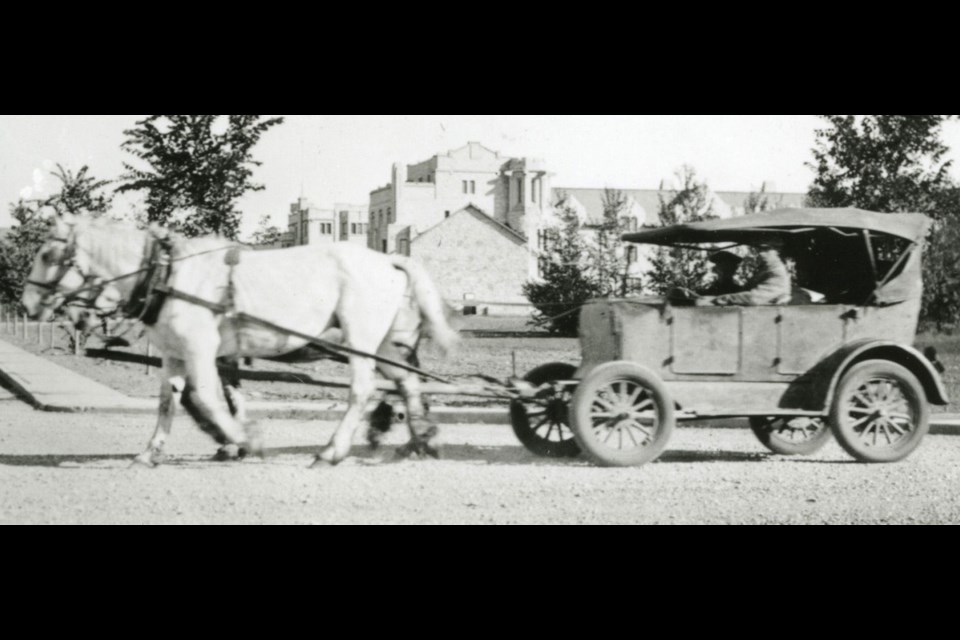The Big Drought. The Dust Bowl. The Hungry Thirties. The Dirty Thirties. The Great Depression.
Whatever that pivotal period of Saskatchewan’s history is called, the effect of a decade-long drought and economic collapse from 1929 to 1939 was horrendous on almost everyone. But those hardy people found ways to cope and make the best of a bad situation.
The Western Development Museum highlighted The Great Depression during a recent online Coffee Club presentation. Karla Rasmussen, the public programs co-ordinator at the Moose Jaw branch, led the talk and used historical photos to showcase what people lived through during that decade.
There was time afterward for participants to ask questions and share any stories they or their families experienced during The Dirty Thirties.
Black blizzards
“On the farm and in the city, everyone had to live with dust, and for a great many people, the events of this period of history led to many living in poverty,” said Rasmussen.
The wind and the sun usually suck the moisture out of the land in Saskatchewan, but there is normally enough snow in the winter and rain throughout the year to replenish, she continued. However, there was almost no moisture during the 1930s, which produced massive dust storms — or “black blizzards” — that caused the soil to build up along fences similar to snowdrifts.
Dust came in through every crack in homes and covered every surface. This forced residents to turn upside their cups and plates so they remained as clean as possible. That didn’t always help, though, as almost everything tasted gritty.
The dust storms appeared on the front pages of newspapers throughout the country, becoming a symbol for this period of history, Rasmussen noted. In southern Saskatchewan, moisture levels during that decade dipped below average — sometimes, there was no moisture at all.
“People joked that there was an entire generation of children that didn’t know what rain was,” she said. “Without moisture, the ground cracked, crumbled, and blew away.”
Bennett buggies
Drought meant a shortage of grain and hay for livestock, which forced producers to ship their cattle north to actual greener pastures, continued Rasmussen. However, horses could not be shipped away since they were important to daily farming life. This included pulling cars that had their engines removed since there was no money for gasoline.
Canadians named these vehicles “Bennett buggies” after Prime Minister R.B. Bennett.
“Many people held him responsible for their economic plight,” Rasmussen remarked, noting some in Saskatchewan cut their vehicles in half and created two-wheeled horse-pulled carts that were nicknamed “Anderson cars” after Saskatchewan Premier James Anderson.
Unfortunately, disaster struck in 1937, when a horse-related disease that mosquitos spread killed more than 50,000 horses. This added to the misery of farmers since their crops were already withering under the hot sun or being devastated by millions of cutworms, grasshoppers and potato bugs that attacked crops and gardens.
“Some people reported that there were so many grasshoppers that blankets of them would block out the sun. They would march like an army eating everything and leaving bare earth behind them,” said Rasmussen.
Gophers swallowed up whatever wheat was left, so cities encouraged people to catch them to receive one cent for every tail. Kids were especially good at capturing the critters, while they were also rewarded for capturing crow and magpie eggs.
Incomes drop
The years-long droughts and invasive pests regularly caused major crop failures. In 1933, farmers could only collect 2.5 bushels per acre, or 25 ice cream pails of grain compared to 10 bushels per acre a decade before, Rasmussen continued. Farmers earned 78 cents per bushel in 1928, but that dropped to 28 cents five years later.
With incomes declining by 70 per cent, many families gave up and headed for the cities — one in four men in Regina were jobless at one point — or to greener pastures. By 1936, 8,000 farmers had abandoned their land, while 36,000 people left Saskatchewan between 1936 and 1941.
Food was difficult to acquire during The Great Depression, so the provincial government brought in train cars from provinces filled with relief supplies, such as prunes, figs, codfish, dried fruit, clothing and maple syrup. Residents were given ration cards that indicated how much food they would receive.
“People were forced to be thrifty and creative. They learned to conserve everything, including water,” Rasmussen said.
Flour-sack dresses
Worn-out clothing was re-used as pillowcases, tablecloths, or clothing for children. Old wool sweaters were unwound and the wool string was saved for other purposes. Mothers turned flour sacks into clothing — such as dresses, pants, or underwear — for their children. While many girls were embarrassed to wear such dresses, they decorated the outfits to bring them life.
Many people were also too proud to receive government handouts or “to be on the dole” and were embarrassed when others found out, continued Rasmussen. Worried that people wouldn’t want to work, the provincial government created “make-work” projects that gave people temporary jobs.
Two notable make-work projects were the construction of the Albert Street Bridge in Regina — known as the longest bridge over the shortest body of water — and the Broadway Avenue Bridge in Saskatoon.
While many people left the province during The Dirty Thirties, many stayed and stuck out the difficulties, she added. While there were some funny stories during this time, the depression left such a major impression that people carried those experiences for the rest of their lives.
The next WDM Coffee Club will be held Tuesday, Aug. 31 at 10 a.m. via Zoom and will be about Saskatchewan’s weather.




